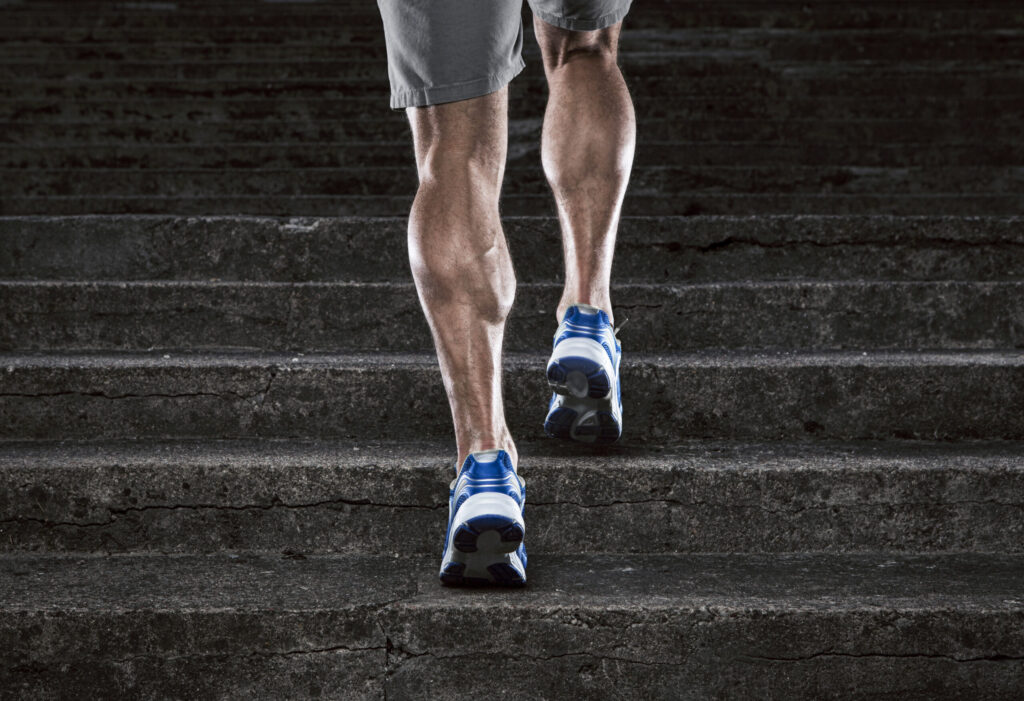Muscles are one of the main elements of vitality and essentially allow us to move. However, one of the first signs of aging is muscle wasting, known as sarcopenia. As we age, our body’s ability to generate muscle decreases. Thus, the loss of muscle reduces our ability to move and increases the risk of falling associated with a loss of balance, all of which causes a loss of autonomy.
The objective of this article is to present the 3 main factors responsible for sarcopenia, namely hormones, the digestive factor and a sedentary lifestyle.
The hormonal factor
Anabolic hormones allow the building of muscle, the main hormone being testosterone. Testosterone secretions begin to decrease from the thirties, with an accentuation of this decrease after andropause in men (around the mid-fifties). It is important to remember that women also experience this decline, even if the mechanisms involve other hormones.
Weight gain, especially body fat, amplifies the fall in testosterone (hypogonadism).
It is in our fat cells that some testosterone is converted into estrogen (aromatase). So, more estrogen is associated with weight gain. We will therefore note a decrease in the production of lean mass (muscle) at the expense of an increase in fat mass. Energy expenditure allows us to understand this balance between muscle and fat mass: muscle makes us burn more energy, even at rest, than fat cells, which are only an inert weight that tend to slow down our metabolism the greater their accumulation. Indeed, it is by losing muscle mass that we lower metabolism, thus causing us to expend fewer calories. And this vicious circle makes us gain weight, as gaining weight decreases testosterone and thus muscle mass: obesity reduces testosterone production, and conversely, the decrease in testosterone levels facilitates weight gain. Indeed, it is by losing muscle mass that we cause the metabolism to drop, which therefore makes us expend fewer calories. And this vicious circle makes us fat, because gaining weight causes testosterone and therefore muscle mass to drop: obesity reduces testosterone production, and conversely, reducing testosterone levels makes it easier to gain weight.
This is even more true for individuals with obese body types (endomorphic).
In lean individuals (neuro-arthritic or ectomorphic types), sarcopenia mainly arises from a protein assimilation and fixation problem. Let’s recall that muscles are composed of amino acids, and a minimum amount of fat is necessary to provide support and maintain some strength.
The digestive factor
A sufficient intake of high-quality proteins (easily usable by the body) is essential to prevent sarcopenia. To obtain the best dietary recommendations, it would be judicious to consult a nutritionist to determine the appropriate amounts of protein for each person.
Animal-based proteins have a higher biological value than most plant-based proteins (legumes, nuts). And since very large quantities of legumes or grains would be needed to obtain a sufficient intake of proteins, this would lead to the production of colonic fermentations that could disrupt assimilation. However, it is pointless to provide significant amounts of proteins if they cannot be well assimilated. And one of the reasons for muscle wasting, especially for lean body types, is the decreased assimilation by the body (digestive capacities) of the digestive organs involved in protein digestion, which is one of the consequences of aging.
Let’s remember that the body renews 200 to 300 grams of proteins per day. For the missing 200 grams, it is capable of synthesizing them from the recycling of elements in cells that have become unnecessary (autophagy), and this process is stimulated by fasting. So, as we age, we no longer recycle properly. [1] But be careful: too little or too much protein will cause a drop in your testosterone. You always need to find the right balance!
Eating too much sugar, too much fat, or consuming too much alcohol also contributes to a decrease in testosterone. Excessive sugar consumption leads to chronically high insulin levels in the blood. Trans fats (hydrogenated fats found in processed foods) also cause a decrease in sperm production in men (Human Reproduction, 2014). As for alcohol, beyond moderate consumption (2-3 drinks depending on body size), regular consumption reduces testosterone levels for 24 hours (Alcohol Journal, 1984, and a more recent article in the Bone journal, 2019). Fructose, trans fat acids, and alcohol are treated by the body as toxins and converted into visceral fat: avoid them as much as possible!

The sedentary factor
Sedentary lifestyle is another major cause of muscle wasting. We have discussed protein assimilation and their fixation in the muscle. Sufficiently stimulating the muscles through movement creates a demand for nutrients, allowing for better assimilation and subsequent amino acids fixation. [1] Muscle loss is inevitable with aging, but it is accentuated by inactivity.
Physical exercise is therefore essential for muscle rebuilding.
Resistance training (weightlifting) with 3 sessions of 45 minutes (per week?) is sufficient to achieve significant muscle gain. Endurance exercises (cycling, jogging, walking, rowing, etc.) can also be beneficial, especially for overweight individuals, but should be avoided for emaciated individuals who are solely looking to increase their muscle mass without losing weight.

Taking care of your muscles is essential for aging healthily.
Here are a few reasons why it is beneficial to strengthen your hands and legs, especially to optimize longevity.
Grip strength is a marker of biological age: chronological age corresponds to the number of years we have lived on Earth, whereas biological age corresponds to the age that represents the function of our cells. Health span is the time spent in our lives without age-related diseases. And this health span is linked to our biological age.
When our cellular function declines, we become more susceptible to age-related diseases such as cardiovascular diseases, cancer, strokes, Alzheimer’s, diabetes, and chronic liver problems. For example:
- A longitudinal study (Haidut, February 2024) found an association between weak grip strength, overall body weakness, and accelerated DNA aging. It has been demonstrated that muscle weakness and testosterone deficiency were strongly correlated and independently associated with morbidity. Grip strength is a general indicator of muscle strength, which is crucial for endurance, balance, and mobility.
- A study (International Journal of Environmental Research and Public Health, 2022) demonstrates an association between grip strength and the immune and inflammatory system.
- Another study (British Heart Foundation, March 2018) demonstrates a correlation between grip strength and cardiovascular diseases, as well as the risk of osteoporosis in postmenopausal women, where stronger grip strength was associated with better functional independence and balance.
- Several studies (BMC Medicine, 2022 and Harvard Health Publishing, September 2022, JAMA Neurology, 2022) have shown a link between weak grip strength and a decrease in dementia and cognitive disorders.
How can you increase your grip strength?
By strengthening your hands (stress ball/hand grips) and forearms (light dumbbells), as well as performing daily hangs on a bar for 90 to 120 seconds.
And why prioritize leg muscles to counter metabolic diseases?
A study (The Journal of Clinical Endocrinology & Metabolism, February 2010) demonstrates that maintaining muscle mass is essential to limit the risk of diabetes, but it is even more effective if the focus is on working the legs.
Other studies demonstrate that improving insulin sensitivity is better achieved through relatively intense exercises (at 80% of maximum intensity), fragmented (for example, 30 seconds of effort followed by 30 seconds of rest), targeting contractions of leg muscles. Why? Because legs contain 2.5 times more blood than arms. Appropriately engaged, they act as glucose sponges and stimulate blood circulation often deficient in individuals with metabolic disorders.
In addition to typical leg exercises (leg curls, lunges, cycling, etc.), it can be beneficial to consider exercises involving small jumps (trampoline, skipping rope, jump squats, etc.). And if you enjoy cycling, aim for just 20 minutes during which you will perform sprints of 30 seconds to 1 minute, interspersed with short recovery phases.
Furthermore, some activities are more suitable for specific body types. Read our article “Morphology: What Does It Tell Us?” to learn more!
[1] Source: Jean-Brice Thivent, naturopath




